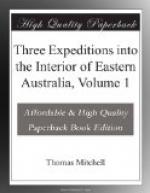(Footnote. Genus, Vespa; subgenus, Abispa; species, Abispa australiana (mihi). Head, antennae, and feet yellow; eyes black; the scutellum of prothorax yellow; the scutum of mesothorax black, with the scutellum yellow; the scutum of metathorax yellow, with the scutellum black, and the axillae yellow. The wings yellow, with dusky tips. The first segment of abdomen has the petiole black. The second segment is black, and the rest yellow.)
Beyond the wood a magnificent sheet of water lay before us and extended like a noble river in a north and south direction. Keeping its eastern bank I traced it southwards until I reached the termination, or rather an interval, where some rocks occurred in its bed, of the same kind as those last mentioned. The produce of gradual decomposition lay around the rocks and seemed to prove that although these masses had been originally denuded by the current which formed the channel, the current had not flowed there for a very considerable time. We encamped between the two lagoons, separated by this interval and these rocks, in latitude 29 degrees 27 minutes 27 seconds South.
February 4.
We continued along the bank of the second lagoon which, turning towards the east, threatened to stop our progress. At length however we arrived at the termination of the water, and passing over the soft mud we proceeded southward to look for the Gwydir, which I knew could not then be far distant. We rode through groves of casuarinae, and over small plains and burnt flats. In one of the thickets we saw two small kangaroos, the first observed since our arrival on the banks of this large river. Emus appeared to be numerous but very wild; pelicans abounded on the lagoons, and seemed to be remarkably tame, considering the remains of them which we saw at the old fires of the natives. It was obvious on various occasions however that the first appearance of such large quadrupeds as bullocks and horses did not scare the emu or kangaroo, but that, on the contrary, when they would have run at the first appearance of their enemy, man, when advancing singly, they would allow him to approach mounted, and even to dismount, fire from behind a horse, and load again, without attempting to run off.
JUNCTION OF THE GWYDIR.
At length we perceived that the ground sloped towards the south, and at the distance of about four miles from where we had slept we made the Gwydir. The course of this river was as tortuous as at our last camp upon it, which could not be distant more than fourteen or fifteen miles. The volume of water was so much reduced that in shallows, where alone the current could be perceived, I could step across it. This stream could not therefore contribute much to that I was tracing, and in search of which I now turned westward. On this course the windings of the Gwydir often came in my way, so that I turned to north 25 degrees east, in which direction I at length reached




